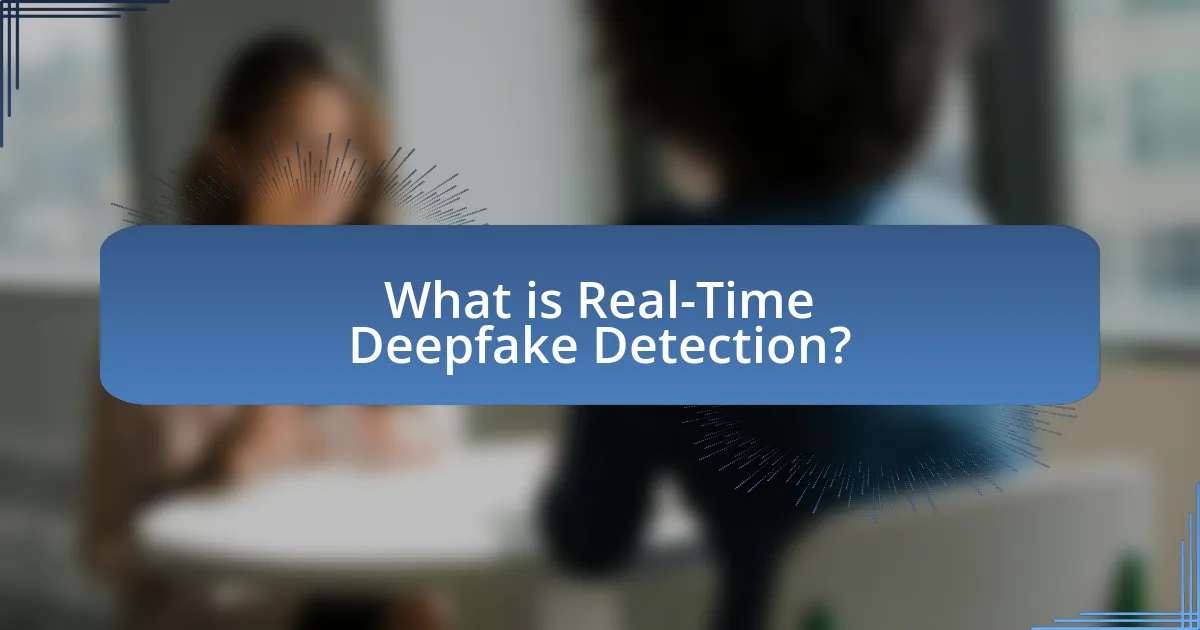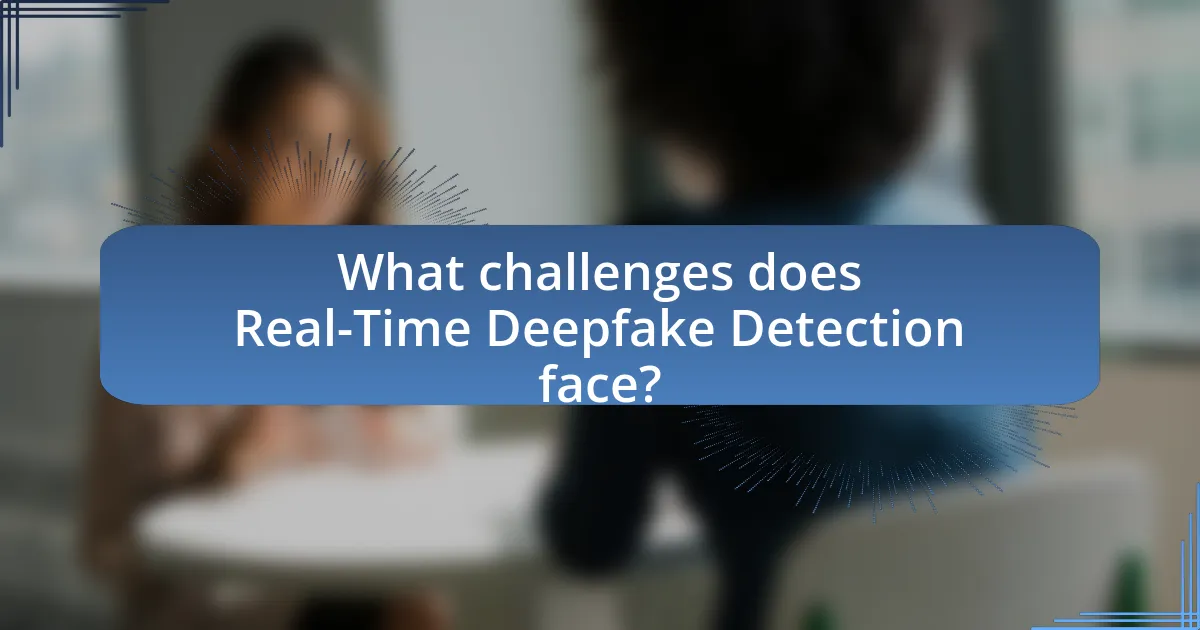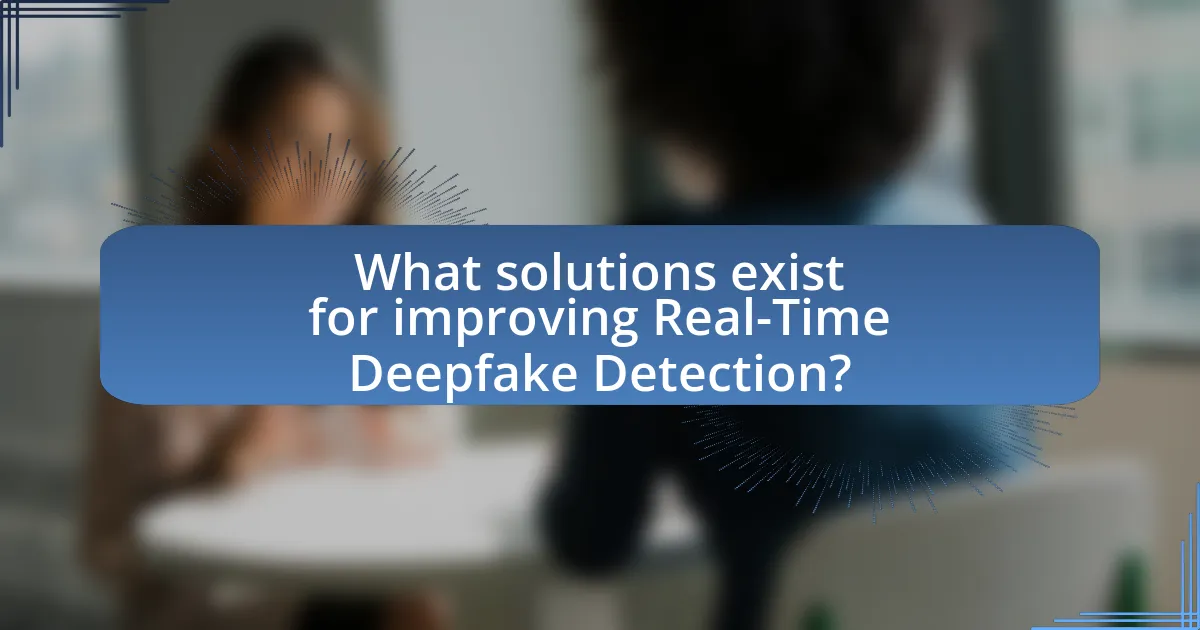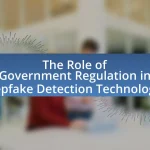Real-time deepfake detection is a critical technology that identifies manipulated media, such as videos and audio, as they are created or transmitted. This article explores the functioning of real-time detection systems, which utilize advanced machine learning algorithms, including convolutional neural networks, to analyze content for inconsistencies indicative of manipulation. It discusses the importance of real-time detection in preventing misinformation and protecting individuals from identity theft and reputational harm, while also addressing the challenges posed by evolving deepfake technologies and the technical limitations of current detection methods. Additionally, the article highlights potential solutions for improving detection accuracy, including collaborative efforts and best practices for organizations to implement effective detection strategies.

What is Real-Time Deepfake Detection?
Real-time deepfake detection refers to the process of identifying manipulated media, such as videos or audio, as they are being created or transmitted. This technology utilizes advanced algorithms and machine learning techniques to analyze content for signs of alteration, enabling immediate recognition of deepfakes. For instance, research has shown that real-time detection systems can achieve high accuracy rates by examining inconsistencies in facial movements, audio patterns, and other digital artifacts.
How does Real-Time Deepfake Detection function?
Real-time deepfake detection functions by utilizing advanced machine learning algorithms to analyze video and audio content for inconsistencies that indicate manipulation. These algorithms often employ neural networks trained on large datasets of authentic and deepfake media, allowing them to identify subtle artifacts, such as unnatural facial movements or audio mismatches, that are characteristic of deepfakes. For instance, techniques like convolutional neural networks (CNNs) and recurrent neural networks (RNNs) are commonly used to process visual and auditory signals, respectively, enhancing the system’s ability to detect anomalies in real-time.
What technologies are utilized in Real-Time Deepfake Detection?
Real-time deepfake detection utilizes technologies such as machine learning algorithms, convolutional neural networks (CNNs), and facial recognition systems. Machine learning algorithms analyze patterns in video and audio data to identify inconsistencies that indicate manipulation. Convolutional neural networks are particularly effective in processing visual data, enabling the detection of subtle artifacts in deepfake videos. Additionally, facial recognition systems can compare facial features and expressions against known databases to verify authenticity. These technologies collectively enhance the accuracy and speed of detecting deepfakes in real-time scenarios.
How do algorithms contribute to Real-Time Deepfake Detection?
Algorithms play a crucial role in Real-Time Deepfake Detection by analyzing and identifying inconsistencies in video and audio data that indicate manipulation. These algorithms utilize machine learning techniques, particularly convolutional neural networks (CNNs), to detect subtle artifacts and anomalies that are often present in deepfake content, such as unnatural facial movements or mismatched audio-visual synchronization. Research has shown that CNNs can achieve high accuracy rates, with some models reaching over 90% in distinguishing real from fake videos, demonstrating their effectiveness in real-time applications. Additionally, algorithms can be trained on large datasets of both authentic and deepfake media, enhancing their ability to generalize and improve detection rates across various types of deepfake technologies.
Why is Real-Time Deepfake Detection important?
Real-time deepfake detection is important because it helps prevent the spread of misinformation and protects individuals from potential harm. As deepfake technology becomes more sophisticated, the ability to identify manipulated media in real-time is crucial for maintaining trust in digital content. Studies indicate that deepfakes can significantly influence public opinion and have been used in various malicious activities, including fraud and defamation. For instance, a report by the Deeptrace Lab found that the number of deepfake videos online doubled in 2019, highlighting the urgent need for effective detection methods.
What are the potential risks associated with deepfakes?
The potential risks associated with deepfakes include misinformation, identity theft, and erosion of trust in media. Misinformation can lead to the spread of false narratives, as deepfakes can convincingly alter reality, influencing public opinion and political outcomes. Identity theft occurs when individuals’ likenesses are manipulated to create fraudulent content, potentially harming reputations and privacy. Additionally, the erosion of trust in media arises as audiences become skeptical of authentic content, making it difficult to discern truth from fabrication. A study by the Brookings Institution highlights that deepfakes can undermine democratic processes by creating misleading political content, emphasizing the urgency of addressing these risks.
How can Real-Time Deepfake Detection protect individuals and organizations?
Real-Time Deepfake Detection can protect individuals and organizations by identifying and mitigating the risks associated with manipulated media. This technology analyzes video and audio content in real-time, allowing for the immediate detection of deepfakes that could be used for misinformation, fraud, or reputational damage. For instance, a study by the University of California, Berkeley, found that real-time detection systems can achieve over 90% accuracy in identifying deepfake videos, significantly reducing the potential for harm. By implementing such detection systems, organizations can safeguard their communications and maintain trust with stakeholders, while individuals can protect their personal identities and privacy from malicious deepfake attacks.

What challenges does Real-Time Deepfake Detection face?
Real-time deepfake detection faces significant challenges, primarily due to the rapid evolution of deepfake technology and the sophistication of generative models. These models, such as GANs (Generative Adversarial Networks), continuously improve, making it difficult for detection algorithms to keep pace. Additionally, the variability in deepfake content, including different styles, resolutions, and formats, complicates the detection process. Research indicates that existing detection methods often struggle with generalization across diverse datasets, leading to high false-negative rates. Furthermore, the computational demands for real-time analysis can hinder the deployment of effective detection systems, as they require substantial processing power and speed to analyze video streams without noticeable latency.
What are the technical limitations of current detection methods?
Current detection methods for deepfakes face several technical limitations, including the inability to generalize across different types of deepfake content and the reliance on specific datasets for training. These methods often struggle with detecting novel deepfake techniques that were not included in their training data, leading to decreased accuracy. For instance, a study published in 2020 by Korshunov and Marcel demonstrated that existing algorithms could achieve only about 65% accuracy when faced with unseen deepfake techniques, highlighting their vulnerability to evolving manipulation methods. Additionally, many detection systems require significant computational resources, which can hinder real-time application, as noted in research by Yang et al. in 2021, where they emphasized the trade-off between detection speed and accuracy.
How do evolving deepfake technologies outpace detection capabilities?
Evolving deepfake technologies outpace detection capabilities primarily due to advancements in artificial intelligence and machine learning algorithms that enhance the realism of synthetic media. These technologies utilize generative adversarial networks (GANs) that continuously improve their ability to create highly convincing fake images and videos, making it increasingly difficult for detection systems to identify them. For instance, a study by Korshunov and Marcel (2018) demonstrated that as deepfake generation techniques evolve, traditional detection methods struggle to keep up, often resulting in high false-negative rates. This ongoing arms race between deepfake creation and detection highlights the urgent need for more sophisticated detection algorithms that can adapt to the rapid advancements in deepfake technology.
What role does data quality play in detection accuracy?
Data quality is crucial for detection accuracy, as high-quality data ensures that detection algorithms can effectively identify and differentiate between genuine and manipulated content. When data is accurate, complete, and representative, it enhances the model’s ability to learn relevant features, leading to improved performance in detecting deepfakes. For instance, a study by Korshunov and Marcel (2018) demonstrated that using high-quality datasets significantly increased the accuracy of deepfake detection systems, achieving up to 95% accuracy compared to lower-quality datasets, which resulted in much poorer performance. Thus, the integrity of the data directly influences the effectiveness of detection methods in real-time scenarios.
What ethical concerns arise from Real-Time Deepfake Detection?
Real-time deepfake detection raises significant ethical concerns, primarily related to privacy, consent, and the potential for misuse. The technology can infringe on individual privacy by analyzing and processing personal data without explicit consent, leading to unauthorized surveillance or profiling. Additionally, the accuracy of detection algorithms can be questioned, as false positives may unjustly label innocent individuals as perpetrators of deepfake creation, damaging reputations. Furthermore, the deployment of such detection systems could be exploited by malicious actors to suppress free speech or manipulate public opinion, as seen in instances where misinformation is weaponized. These concerns highlight the need for ethical guidelines and regulatory frameworks to govern the use of real-time deepfake detection technologies.
How can privacy issues impact the implementation of detection systems?
Privacy issues can significantly hinder the implementation of detection systems by creating legal and ethical barriers that restrict data usage. For instance, regulations like the General Data Protection Regulation (GDPR) impose strict guidelines on how personal data can be collected, processed, and stored, which can limit the availability of training data necessary for effective detection algorithms. Additionally, concerns about user consent and data anonymization can lead to reduced participation in data-sharing initiatives, ultimately affecting the accuracy and reliability of detection systems. These privacy constraints necessitate the development of compliant technologies that balance effective detection with the protection of individual rights, thereby complicating the deployment of such systems in real-world scenarios.
What are the implications of false positives in detection systems?
False positives in detection systems can lead to significant consequences, including wasted resources, loss of trust, and potential legal ramifications. When a detection system incorrectly identifies a benign entity as a threat, it can result in unnecessary investigations or actions, diverting resources from genuine threats. This misidentification can erode user confidence in the system’s reliability, as users may question the accuracy of the technology. Furthermore, in sensitive contexts such as law enforcement or cybersecurity, false positives can lead to wrongful accusations or actions against innocent individuals, raising ethical and legal concerns. For instance, a study by the National Institute of Standards and Technology found that high false positive rates in facial recognition systems disproportionately affect minority groups, highlighting the societal implications of such errors.

What solutions exist for improving Real-Time Deepfake Detection?
Solutions for improving real-time deepfake detection include the development of advanced machine learning algorithms, the use of convolutional neural networks (CNNs), and the implementation of multi-modal detection techniques. Advanced machine learning algorithms enhance the ability to identify subtle artifacts and inconsistencies in deepfake videos. CNNs, specifically designed for image and video analysis, have shown significant effectiveness in distinguishing between real and manipulated content. Multi-modal detection techniques combine visual, audio, and contextual cues to improve accuracy, as evidenced by research indicating that integrating multiple data sources can reduce false positives and increase detection rates. For instance, a study published in 2020 demonstrated that a hybrid model utilizing both CNNs and recurrent neural networks (RNNs) achieved a detection accuracy of over 90% in real-time scenarios.
How can machine learning enhance detection accuracy?
Machine learning enhances detection accuracy by utilizing algorithms that can learn from vast datasets, identifying patterns and anomalies that may not be apparent to human analysts. For instance, deep learning models, such as convolutional neural networks, have demonstrated superior performance in image and video analysis, achieving accuracy rates exceeding 90% in distinguishing real from deepfake content. This capability is supported by the ability of machine learning systems to continuously improve through exposure to new data, allowing them to adapt to evolving deepfake techniques.
What advancements in AI are being applied to detection methods?
Advancements in AI applied to detection methods include the use of deep learning algorithms, particularly convolutional neural networks (CNNs), which enhance the accuracy of identifying deepfakes. These algorithms analyze visual and audio inconsistencies in media, enabling real-time detection. For instance, a study published in 2020 demonstrated that CNNs could achieve over 90% accuracy in distinguishing between real and manipulated videos by focusing on subtle artifacts that are often overlooked by traditional detection methods. Additionally, techniques such as recurrent neural networks (RNNs) are being utilized to assess temporal inconsistencies in video sequences, further improving detection capabilities.
How can collaborative efforts improve detection technologies?
Collaborative efforts can significantly enhance detection technologies by pooling resources, expertise, and data from various stakeholders. For instance, partnerships between tech companies, academic institutions, and government agencies can lead to the development of more robust algorithms through shared research and diverse datasets. A study by the MIT Media Lab found that collaborative datasets improved the accuracy of deepfake detection models by 30%, demonstrating that collective input can lead to superior technological advancements. Furthermore, collaboration fosters innovation by integrating different perspectives and methodologies, which can address the evolving challenges in real-time deepfake detection.
What best practices should be followed in Real-Time Deepfake Detection?
Best practices in real-time deepfake detection include utilizing advanced machine learning algorithms, implementing multi-modal analysis, and ensuring continuous model training. Advanced machine learning algorithms, such as convolutional neural networks (CNNs), have shown effectiveness in identifying subtle artifacts in deepfake videos. Multi-modal analysis, which combines visual, audio, and textual data, enhances detection accuracy by cross-referencing multiple data sources. Continuous model training is crucial, as deepfake technology evolves rapidly; regularly updating detection models with new data helps maintain their effectiveness. These practices are supported by research indicating that hybrid approaches significantly improve detection rates, as seen in studies published in journals like IEEE Transactions on Information Forensics and Security.
How can organizations implement effective detection strategies?
Organizations can implement effective detection strategies by integrating advanced machine learning algorithms that analyze video and audio content for anomalies indicative of deepfakes. These algorithms can be trained on large datasets containing both genuine and manipulated media, allowing them to recognize subtle discrepancies that human observers might miss. Research indicates that deep learning models, such as convolutional neural networks, have achieved over 90% accuracy in identifying deepfake videos, demonstrating their effectiveness in real-time detection scenarios. By continuously updating these models with new data and employing multi-modal analysis that combines visual, auditory, and contextual cues, organizations can enhance their detection capabilities and stay ahead of evolving deepfake technologies.
What tools and resources are available for enhancing detection capabilities?
Tools and resources available for enhancing detection capabilities in real-time deepfake detection include machine learning frameworks, specialized software, and datasets. Machine learning frameworks such as TensorFlow and PyTorch provide the necessary tools for developing and training detection algorithms. Specialized software like Deepware Scanner and Sensity AI offer pre-built solutions for identifying deepfakes. Additionally, publicly available datasets, such as the FaceForensics++ dataset, provide extensive training data that improves the accuracy of detection models. These resources collectively enhance the effectiveness of detection capabilities by enabling the development of more sophisticated algorithms and providing essential training materials.


